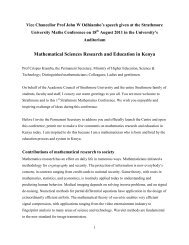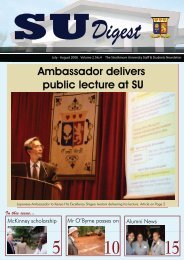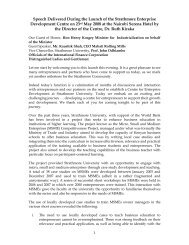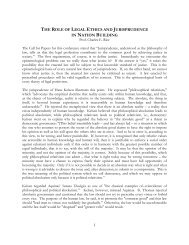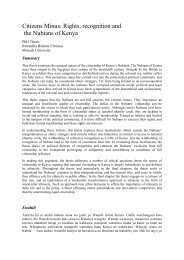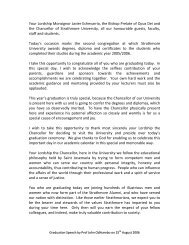Lucy-Gikonyo-paper Nataka-Chakula.pdf - Strathmore University
Lucy-Gikonyo-paper Nataka-Chakula.pdf - Strathmore University
Lucy-Gikonyo-paper Nataka-Chakula.pdf - Strathmore University
- No tags were found...
Create successful ePaper yourself
Turn your PDF publications into a flip-book with our unique Google optimized e-Paper software.
Introduction<br />
The restaurant industry has developed and expanded to gain a global presence in the last<br />
fifty years largely fuelled by the change of lifestyles. Urban populations have grown<br />
throughout the world, mobility of people has increased and people spend a lot of time<br />
commuting to and from work (Schlosser, 2001). This has been compounded by the<br />
increased presence of women in the workplace which has resulted in less time available for<br />
them to prepare meals at home (Jekanowski, Binkley & Eales, 2001). These busier<br />
consumer lifestyles and dual-working families have led to solutions being sought in using<br />
readymade meals (Atkins and Bowler, 2001). For a long time, growth and expansion in the<br />
restaurant industry has been associated particularly with the fast food concept (Lashley &<br />
Morrison, 2004; Sen 1998).<br />
Viewed from the customers’ perspective, Anderson and Fornell (2000) assume that<br />
businesses exist and compete to satisfy the customers. They suggest that it is not possible<br />
to grow a business without at the same time increasing customer satisfaction. A satisfied<br />
customer will become a repeat customer and this could in turn grow a business. Following<br />
this general business imperative therefore it means that a satisfied customer will have a<br />
critical effect on the long-term success of restaurant business. A satisfied restaurant<br />
customer will remain loyal to an outlet or restaurant business and continued patronage can<br />
follow a global pattern. On the other hand a dissatisfied customer of restaurant will not<br />
only avoid the entire franchise or chain outlets but may also make bad publicity and<br />
persuade many people to go elsewhere (Gilbert et al, 2004). This presents an eating<br />
establishment (such as a restaurant) with a challenge. They need to satisfy customers to<br />
gain repeat business, but what do they need to do Where should a restaurant focus their<br />
energies and attention if they are to not only attract new customers but also to keep existing<br />
customers satisfied The focus of attention is on what are regarded as the Critical Success<br />
Factors (CSFs), but there is little published research on CSFs in the restaurant industry in<br />
Africa, a gap this study aims to fill.<br />
2





